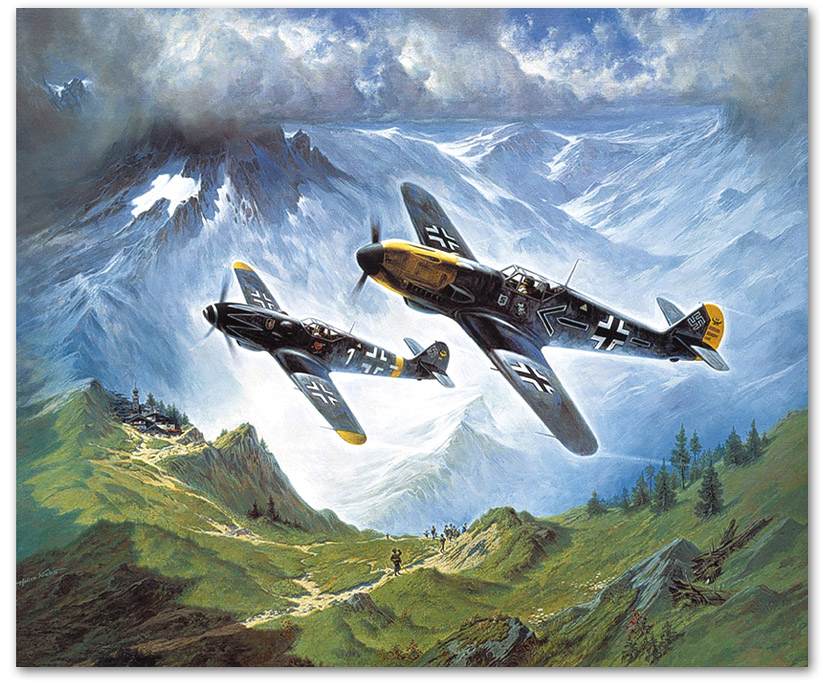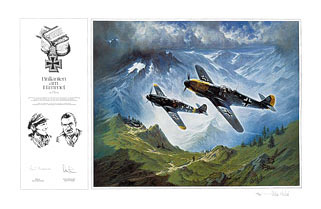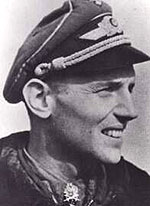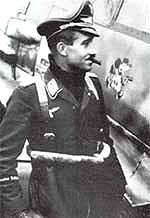
Diamonds in the Sky
by Heinz Krebs
| Adolf Galland, commanding General of all Luftwaffe fighters, and Erich Hartmann, with 352 aerial victories the ace of all fighter aces, fly their Me 109 fighters through the majestic landscape of the Alps. Both are recipients of the very rare decoration; Oak Leaves, Swords, and Diamonds with the Knight's Cross of the Iron Cross. The signature area on this print is placed to the left of the image, please see below. |
| Overall size: 27" x 39" | Available in the following editions |
| 1500 | Ltd. edition | Signed by Adolf Galland and Erich Hartmann | LOW INVENTORY | $650 |
 |
 Erich Hartmann Erich HartmannErich “Bubi” Hartmann was born on 19 April 1921 at Weissach in Württemberg. His early years were spent in China where his father, a doctor, had a general practice in Changsha. He returned to Germany with his family in 1928 and completed his schooling. Hartmann learned to fly sailplanes and had gained his pilot’s licence in 1939. He entered the Luftwaffe on 10 October 1940. Hartmann attended the Luftkriegsschule II (air combat school) at Berlin-Gatow gaining his military pilot’s licence in August 1941. His first operational posting was to 7./JG 52 on the Eastern Front on 10 October 1942. Leutnant Hartmann came under the guidance of Oberfeldwebel Edmund “Paule” Rossmann, considered one of the best element leaders on the Eastern Front. During this time he was given the advice of several another accomplished aces of 7./JG 52, including Oberfeldwebel Alfred Grislawski and Leutnant Walter Krupinski. Hartmann recorded his first victory, a Russian Il-2 Sturmovik ground-attack aircraft, shot down on 5 November 1942. However, he too was hit in the engagement and was forced to crashland. By the end of April 1943, his victory total stood at 11. On 23 May he claimed his 17th victory but two days later force-landed his Bf 109 G-4 “White 2” after colliding with a LaGG-3 fighter. After this incident he was given leave to rest and recuperate, returning to combat duty by the end of June. By the end of July 1943 his victory total had reached 42, including seven enemy aircraft shot down on 7 July to record his 22nd through 28th victories. In August, he claimed 48 victories, including five on 1 August (43-47), 4 August (52-56), 5 August (57-61) and 7 August (63-67). However, following his 90th victory on 20 August 1943, Hartmann was shot down in Bf 109 G-6 , and captured. Feigning injury, he managed to decoy his captors into not keeping a close watch on him and was able to escape and returned to his unit after two days. On 2 September 1943, Hartmann was appointed Staffelkapitän of 9./JG 52. On 13 September he was awarded the Ehrenpokal. He gained his 100th victory on 20 September 1943. In October, he claimed 33 victories. Leutnant Hartmann was awarded the Ritterkreuz on 29 October 1943 after his 148th victory. On 6 December he was awarded the Deutsches Kreuz in Gold. He recorded his 150th victory on 13 December. On 30 January 1944, Hartmann shot down six enemy aircraft (178-183). He claimed five victories on 1 February (186-190). He brought up his 200th victory on the 26 February 1944, on a day when he shot down 10 Airacobra fighters (192-202). He was awarded the Eichenlaub (Nr 420) on 2 March. On 8 May, Hartmann, with two of his groundcrew in the baggage locker of his Bf 109, was forced to withdraw from the Crimea. He had 223 victories to his credit at the time. For a short period, Hartmann operated over Rumania intercepting the American daylight bombing raids on the Rumanian oil fields and installations, and on 24 June he claimed a 15th USAAF P-51 fighter as his 265th victory. On 2 July he was awarded the Schwertern (Nr. 75) for 266 victories. A Russian counter-offensive took the unit back to the Crimea and, during May and June 1944, he accounted for 60 Russian aircraft to bring his score to 267. In August 1944, Hartmann claimed 35 victories, including eight on 23 August (284-291). He became the first fighter pilot to record 300 victories on 24 August 1944, on a day when he shot down eleven enemy aircraft. Hartmann was awarded the Brillanten for 303 victories on 25 August 1944, only the 18th German soldier to receive this accolade. He was immediately prohibited from combat flying and was assigned to Erprobungskommando 262 to test fly the Me 262 jet fighter. In October, Hartman was able get the prohibition on his combat flying lifted. On 1 October he was appointed Staffelkapitän of 4./JG 52 (or 7./JG 52?) based in Hungary. By the end of 1944, he had raised his victory tally to 331. From 1 to 14 February 1945, Hartmann briefly led I./JG 53 in an acting Gruppenkommandeur role. He relinquished the role to Hauptmann Helmut Lipfert (203 victories, RK-EL) on 15 February. In mid-February 1945, Hartmann was given command of I./JG 52. In March he was transferred to Lechfeld for short training on the Me 262 jet fighter before requesting to return to JG 52. He became the only man ever to achieve 350 victories on 17 April 1945 and in late April he was promoted to Major. On 8 May 1945 he claimed his 352nd, and last, victory against a Yak-9 fighter over the Brünn area in Czechoslovakia. Major Hartmann surrendered his unit to an American armoured unit but on 24 May he was handed over to the Russians. He was to be sentenced to 25 years hard labour by the Russians, serving 10 years before returning to Germany on 15 October 1955. He served in the reformed Luftwaffe from 1956 and commanded JG 71. He retired from active duty in 1970. Erich Hartmann died on 19 September 1993 at Weil im Schönbuch. Erich Hartmann was the top scoring fighter pilot of all the combatants in World War 2. He flew 825 missions in recording 352 victories. All his victories were recorded on the Eastern Front and included 15 Il-2 Sturmovik ground-attack aircraft. He force-landed 14 times during his combat career. |
Adolf “Dolfo” Galland was born on 19 March 1912 at Westerholt, Westphalia. At the age of 17 he started flying gliders, and began flying for Lufthansa after graduating from the German Commercial Air Transport School at Brunswick. In February 1934, he joined the Luftwaffe, by April 1935 he was a fighter pilot with Jagdgeschwader 2 “Richtofen”. In 1937, he volunteered for service with the Condor Legion in Spain. Galland was put in command of 3 Staffel of J/88, completing 280 combat sorties before being relieved by Werner Mölders in mid-1938. When World War 2 broke out Oberleutnant Galland was a Staffelkapitän of 4.(S)/LG 2 equipped with the Henschel Hs 123, a biplane Stuka. He took part in the invasion of Poland flying 50 ground attack missions. Galland was posted away to JG 27 at Krefeld, arriving there on 15 February 1940. He was assigned to the Geschwaderstab and assumed the role of Geschwader Adjutant. On 12 May, west of Liege, Belgium, he scored his first aerial victory. Two more victories followed that day. All three victims were RAF Hurricanes. By the end of the French campaign he had accumulated 14 victories. On 6 June 1940, Hauptmann Galland was appointed Gruppenkommandeur of III./JG 26. Promoted Major on 18 July, Galland stayed with III./JG 26 through the Battle of Britain. On 1 November 1940, Galland was promoted to Oberstleutnant and given command of JG 26. On 21 June 1941, Galland was shot down, by the Polish ace Boleslaw Drobinski of 303 Sqn, RAF, and baled out wounded. Galland had, by now, been ordered by Hitler and Göring not to fly combat missions. However, he disregarded these orders and continued to rack up aerial victories. On the death of Oberst Werner Mölders on 22 November 1941, Galland was named General der Jagdflieger. Before settling into his new job, Oberst Galland directed the fighter protection for the Channel dash of the battleships Scharnhorst and Gneisenau, and the heavy cruiser Prinz Eugen, from Brest. Galland became one of the most controversial figures of his time through his skirmishes with Reichsmarschal Göring and his frank addresses to Hitler when he emphasized the need for more fighters to oppose the increasingly intense allied bombing raids over Germany. Galland’s contemporaries in combat commands eventually began planning to force Göring’s resignation, by seeking an audience with Hitler. Although Galland took no direct part in such activities, Göring attributed the incipient mutiny to Galland, sacked him and prepared a trial. Hitler intervened but then insisted, as an end to the “Galland affair”, that he be given command of a unit of jet fighters. Galland led JV 44 until 26 April 1945 gaining up to seven victories flying the Me 262 jet fighter. On that day day he was bounced by a P-47 flown by 1st Lt James J Finnegan of the 50th Fighter Group, USAAF. Galland was wounded in the right knee and his aircraft received further damage. He was able to bring his crippled jet back to München-Reim and successfully land, but the wounds suffered in this encounter were serious enough to end his combat flying. Galland surrendered himself to American forces at Tegernsee on 5 May 1945. He was held in military custody for two years. He was released in 1947. Adolf Galland passed away on 9 February 1996 at Remagen-Oberwinter. Galland achieved 104 aerial victories in 705 missions, all on the Western front. Included in his
score are at least seven victories flying the Me 262. He was
himself shot down four times. |
| Receive your print fully framed and ready to display. Please call or email us for a custom framing quote. |
 Adolf Galland
Adolf Galland